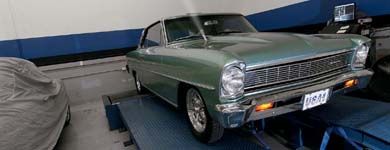
The quest for enough horsepower is a frustrating one. It seems like no matter how much you get, you just end up wanting more. The desire to have more ponies generally leads to bigger cams, higher-flowing heads, and a host of other upgrades. The only problem is this extra power comes at a big cost. Maybe you get less gas mileage, or a cam becomes so lopey, it's troublesome on the street. Enter nitrous oxide: the magical combination of atoms that lets the user run a relatively mild engine and still put down serious power with just the flip of a switch.
Nitrous oxide works by introducing extra oxygen into the intake charge, which allows more fuel to be added and converted into energy. This can greatly increase the power produced by the engine. Another benefit is that evaporation in the intake manifold helps drop the intake charge temperature, since nitrous oxide is stored as a high-pressure liquid. This evaporative cooling causes a denser charge, and can increase power output, as well as reduce detonation.
But like everything in life that sounds perfect, there's a price-and this time it's vigilance. When using nitrous, you have to be careful with bottle pressure, fuel pressure, ignition timing, and other factors. If all is set up properly, it can be a beautiful thing; if not, disaster looms.
We wanted to see how a basic nitrous system could up the power on an average engine. Our test mule was a '66 Nova, with a fairly sedate 350 small-block engine. For a system, we chose Zex's new perimeter plate setup, whose innovative design caught our attention. The Zex system is known as a perimeter plate, meaning that the nitrous and enriching fuel are introduced into the plenum below the carb through a series of small, evenly spaced holes. This reduces-or in some cases eliminates-the uneven distribution encountered with other systems.
The owner of our test Nova, Scott Miller, wanted to know if he should switch his dual-plane intake to a single-plane, so we called up Zex to ask. Zex's Matt Patrick tells us, "Our perimeter injection plate is ideal for use with dual-plane intake manifolds. Traditional spray-bar-type plates have difficulty with proper distribution, due to the center divider being placed directly under the spray bar. Since the injection spray with the perimeter plate occurs around the outer edge of the manifold plenum, distribution of the nitrous and fuel is excellent. In fact, our dyno tests proved that the perimeter injection design actually decreased the engine's normal cylinder-to-cylinder mixture variations." With that bit of information, we were ready to start the install. And after that, we did baseline, 100 hp, and 150 hp shot dyno pulls, and saw a peak-to-peak increase of up to 93 hp to the rear wheels. Check out the details of this easy weekend horsepower upgrade.
Stuff you'll need:
*Basic wrench and ratchet set
*Selection of screwdrivers
*Tubing bender for the purge line
*Extra 18-gauge wire
*A drill and various bits
*Extra zip ties
*Wire crimper
*Timing light
*Extra fuel line
ZEX On The Dyno
The plan was to make a couple of baseline pulls, then to try pulls with the 100hp and 150hp jets. The 10:1 350 was running 91-octane gas, so even the 150 shot was pushing it a bit. The base runs were done at 38 degrees of total timing. For the nitrous, Miller retarded the timing 4 degrees for the 100 shot, and another 2 degrees for the 150 shot. We ended up making an additional 59 hp (peak-to-peak), and 85 ft-lbs of torque with the 100 shot. Then we moved up to the 150hp jets, and saw 93 hp and 164 lb-ft over the naturally aspirated baseline. (That's a gain of over 70 percent in rear-wheel torque.) On the last run, we picked up a tiny bit of detonation, so Miller will bump up the octane with racing gas when he hits the track.
Dyno Runs-Rear-Wheel PowerBaseline (corrected), 38 degrees timing
211 hp at 5,012 rpm, 230 lb-ft torque at 4,251 rpm
100 Shot (corrected), 34 degrees timing
270 hp at 5,264 rpm, 315 lb-ft torque at 4,046 rpm
150 Shot (corrected), 32 degrees timing
304 hp at 5,060 rpm, 394 lb-ft torque at 3,899 rpm